Did I goof on my Comtesse de Brouchard?
pippi21
13 years ago
Related Stories

HOUZZ TOURSHouzz Tour: Spanish Colonial–Modern Union in California
Styles, eras and objects from far-flung places happily coexist in this Spanish colonial home
Full Story
MOST POPULAR8 Great Kitchen Cabinet Color Palettes
Make your kitchen uniquely yours with painted cabinetry. Here's how (and what) to paint them
Full Story
BATHROOM DESIGNHow to Settle on a Shower Bench
We help a Houzz user ask all the right questions for designing a stylish, practical and safe shower bench
Full Story
SHOWERSYour Guide to Shower Floor Materials
Discover the pros and cons of marble, travertine, porcelain and more
Full Story
FEEL-GOOD HOMEGuys Tell Us About Their Favorite Places at Home
For Father’s Day, Houzz men show us the places in their homes where they like to hang out
Full Story







kentstar
pippi21Original Author
Related Professionals
Bellflower Landscape Architects & Landscape Designers · Clark Landscape Architects & Landscape Designers · La Marque Landscape Architects & Landscape Designers · Palm Springs Landscape Architects & Landscape Designers · Seabrook Landscape Architects & Landscape Designers · Forest City Landscape Architects & Landscape Designers · Berkley Landscape Contractors · Bowie Landscape Contractors · Bristol Landscape Contractors · Cambridge Landscape Contractors · Lemoore Landscape Contractors · Mastic Beach Landscape Contractors · Mission Landscape Contractors · Chicago Ridge Landscape Contractors · Windsor Ironworkbuyorsell888
woodyoak zone 5 southern Ont., Canada
kentstar
hannesdp
hannesdp